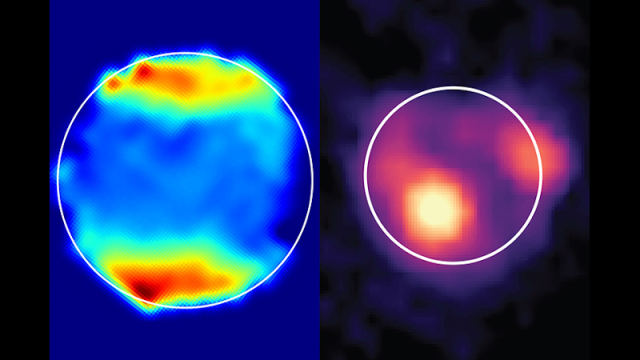Two new studies associated with the James Webb Space Telescope’s Early Release Science program have been published, and both have to do with Jupiter’s moons, namely Ganymede and Io.
The first study, led by astronomer Samantha Trumbo from Cornell University and published in Science Advances, presents a fascinating first—the unprecedented detection of hydrogen peroxide on Ganymede. The second study, published in JGR: Planets, reveals another neat finding—sulfurous fumes, specifically sulfur monoxide, on Io.
Both discoveries are linked by a rather powerful force: Jupiter’s immense influence on its natural satellites. And both studies were made possible by astronomy’s new superstar—the James Webb Space Telescope (JWST).
“This shows that we can do incredible science with the [JWST] on solar system objects, even if the object is really very bright, like Jupiter, but also when you look at very faint things next to Jupiter,” Imke de Pater, an astronomer at the University of California-Berkeley, explained in a press release.
Disinfectant at the poles
For the Ganymede survey, the team used Webb’s near-infrared spectrometer (NIRSpec) to see how light was absorbed by hydrogen peroxide (H2O2) near the moon’s polar regions. The presence of this chemical, which we use on Earth as a disinfectant and bleaching agent, results from the interaction between charged particles around Jupiter and Ganymede, and the ice covering the moon.
Webb telescope “revealing the presence of hydrogen peroxide at Ganymede’s poles shows for the first time that charged particles funnelled along Ganymede’s magnetic field are preferentially altering the surface chemistry of its polar caps,” said Trumbo. As a relevant aside, Ganymede is the only moon in the solar system known to host its own magnetic field.
The team argues that radiolysis—the process whereby radiation breaks down molecules—is behind hydrogen peroxide production on Ganymede. “Just like how Earth’s magnetic field directs charged particles from the sun to the highest latitudes, causing the aurora, Ganymede’s magnetic field does the same thing to charged particles from Jupiter’s magnetosphere,” Trumbo added. “Not only do these particles result in aurorae at Ganymede, as well, but they also impact the icy surface.”
Hydrogen peroxide has also been detected on Europa, another Jovian moon, and it’s observed over a large part of the moon’s surface. This is partly because Europa doesn’t have a magnetic field, which would normally protect the surface from incoming, fast-moving particles.
Reactive gas around Io
The second study details Webb’s observations of Io, which revealed the presence of multiple ongoing eruptions on the volcanic moon. This included a brightening at Loki Patera—a volcanic complex—and a very bright eruption at the volcano Kanehekili Fluctus. Volcanic activity on Io is the result of enormously strong gravitational forces exerted by Jupiter, which creates tidal heating inside the blistered moon. Of significance, the team, which included de Pater, linked a volcanic eruption to the gas sulfur monoxide (SO), specifically the eruption at Kanehekili Fluctus.
“This is the first time this emission has been seen above an active volcano, and suggests that such emissions are produced by [sulfur monoxide] molecules immediately upon leaving the vent,” the scientists write in the paper. The observation was made on November 15, 2022, when Io was in the shadow of Jupiter, thus preventing Jupiter’s reflected light from overpowering Io’s own light.
Io’s atmosphere mainly consists of sulfur dioxide (SO2), a product of melting sulfur dioxide ice and volcanic eruptions. These volcanoes also produce sulfur monoxide, which is difficult to detect. When in Jupiter’s shadow, however, the sulfur dioxide in Io’s atmosphere freezes onto the surface, leaving behind sulfur monoxide and newly emitted volcanic sulfur dioxide gas. Beneficially, the glowing sulfur monoxide becomes visible when cast within Jupiter’s shadow.
De Pater previously observed Io using the Keck Telescope in Hawaii and discovered low levels of SO emissions across the moon, but couldn’t link them to any active volcano. She suspects these emissions, along with the SO2 observed during an eclipse, come from hidden volcanoes that release gas but no visible dust. Two decades ago, De Pater’s team suggested that the rare state of SO emissions could only occur in hot volcanic vents and last long enough in a sparse atmosphere to emit a specific light wavelength, similar to how Earth’s auroras are produced.
“The link between SO and volcanoes ties in with a hypothesis we had in 2002 to explain how we could see SO emission at all,” de Pater explained. “The only way we could explain this emission is if the SO is excited in the volcanic vent at a temperature of 1,500 Kelvin [ 2,240 degrees Fahrenheit] or so, and that it comes out in this excited state, loses its photon within a few seconds, and that is the emission we see. So these observations are the first that actually show that this is the most likely mechanism of why we see that SO.”
De Pater noted that Loki Patera’s brightening aligned with its eruption cycle, in which it brightens roughly every 500 Earth days for a few months.
Webb continues to astound, whether it’s by making discoveries millions of light years away, or just a few million miles from home.
For more spaceflight in your life, follow us on Twitter and bookmark Gizmodo’s dedicated Spaceflight page.
